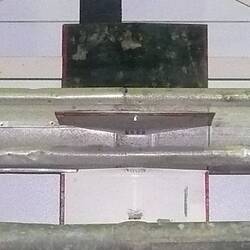Summary
The Research Test Vehicle (RTV) 1e was developed and tested at the Woomera Rocket Range in South Australia by Fairey Aviation. The RTV 1e was a two-stage liquid fuel rocket used for research and development into problems associated with beam riding missiles. It was fired at an angle of 35 degrees with a maximum altitude of about 12,000 feet. The RTV 1e was launched by seven solid booster rockets which had a burn time of four seconds, after which the liquid fuel sustainer motor took over. It was guided by radar.
The original design can be traced back to the 1944 Royal Navy specification for a guided anti-aircraft missile known as LOP/GAP. In 1947, the Royal Aircraft Establishment took over development work and the missile was renamed RTV1. Several versions of the basic RTV1 were developed with RTV1e being the beam guidance round. Radar guidance was provided by a SCR584 radar unit which projected a narrow beam. In Australia, The Fairey Aviation Company of Australiasia Pty Ltd was awarded a contract to build 40 RTV1e rockets. The first of which were completed in early 1954. Components were built by the Royal Australian Navy Torpedo Establishment (hydraulic servo units), EMI (guidance receivers and amplifiers) and the Commonwealth Aircraft Corporation (magnesium castings). Some parts were also imported from the UK. Assembly was undertaken at Salisbury, South Australia by the Fairey Aviation Company Special Projects Division. Test firings took place in 1955-56 but by this time the RTV1 was considered obsolete.
The Museum has two examples of the RTV1e second stage rocket in its collection (ST 35159 & HT 21616). One has had its casing replaced with clear plastic for display purposes. They were donated by the Department of Supply in 1962. It also holds an example of the Stage 1 Booster Unit (ST 26129).
Physical Description
Sectioned example of a Research Rocket.
More Information
-
Collecting Areas
-
Acquisition Information
Donation from Commonwealth Department of Supply, circa 1962
-
Manufacturer
Fairey Aviation, Adelaide, Greater Adelaide, South Australia, Australia
-
Place & Date Tested
Australia: Defence Department, Weapons Research Establishment (WRE), Salisbury, South Australia, Australia, 1955
-
Place Used
-
Inscriptions
Marked with red stencilled serial No. 564.
-
Model Name or Number
-
Brand Names
-
Classification
-
Category
-
Discipline
-
Type of item
-
References
[Book] Morton, Peter R. Fire across the desert : Woomera and the Anglo-Australian Joint Project 1946-1980.
-
Keywords
Atmospheric Rockets, Research Rockets, Rocket Launching Ranges, Rockets


